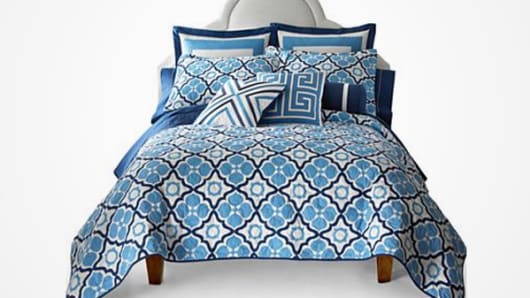This housing improvement, along with rising consumer confidence, could be helping boost sales in home goods category as well, said Brian Nagel, a retail analyst at Oppenheimer. In a note issued Friday, Oppenhieimer noted that a prolonged recovery will likely be a sustained drive of consumer spending going forward.
"Basically if you have new household formation, for example people moving out of their parents' homes, I think that's helping drive furniture sales and home furnishings," he said.
For consumers who don't necessarily have the cash to remodel a whole room, purchasing home goods offers a way to spruce things up on a lower budget, said Debra Mednick, the chief home industry analyst at the NPD Group. She said companies' emphasis on home goods is a trend that's occurred over time.
"They understand that consumers, given the tougher economic times, (will) seek out items that have a lower cost of entry to make them feel good, little luxuries," Mednick said.
But the strategy by J.C. Penney and Target is not without some risk. Despite the increased interest, analysts expect the space's growth to cool somewhat moving forward. IBM expects home-goods sales growth to slow to 0.9 percent during the second quarter. Still, it forecasts that appliances sales would advance more than 3 percent higher.
"It may have reached its critical mass," Mednick added. "I don't know that it's going to shift or change much from where it is today."
For struggling retailer J.C. Penney, the success of its home goods makeover will be crucial to the company's continuing turnaround attempt. The department, which once accounted for about 20 percent of the company's sales, declined to a mere 10 percent of sales, said the company's recently ousted CEO Ron Johnson during its fourth-quarter earnings call. The sales drop per square foot is even more staggering, reflecting a drop to less than $80 per square foot from $185, he said.
(Read more: JC Penney Cites Ousted CEO's Plans in Sales Miss)
In hopes of increasing sales, Johnson, who first made a name for himself in Target's home department in the 1990s, decided to remodel a large portion of the company's home departments and bring in well-known designers, such as Jonathan Adler and Michael Graves. On Tuesday, the company noted that the renovations had contributed to an anticipated 16.4 percent decline in total first-quarter sales.
Once the company finishes its home renovations, analysts will be watching closely to see if the new designs help J.C. Penney's poor sales recover, one strategy of Johnson's that the company has decided not to dismantle.
"It's a pretty big deal," Nagel said. "The ultimate success of this turnaround will be driven at least in part by home."
Penney's added home emphasis represents an effort to return to its former roots as a "home goods destination," NPD's Mednick said.
Discount retailer Target is also stepping up promotions within the home department by launching Threshold, its exclusive line of home decor, bedding and furniture. After slowly introducing items in stores, the company completed its rollout in March.
(Read more: Target Tests If Facebook-Driven Deals Bring Shoppers)
To celebrate the line, Target set up a life-size two-story dollhouse filled with merchandise, some of which could be purchased via QR codes, in New York City's Grand Central Terminal, a commuting hub that serves about 750,000 people each day.
In an interview on Target's style blog, Julie Guggemos, the company's vice president of product design and development, said her team has more than doubled during the past three years.
"We know how important great design is to our guest," she said. "And to maintain Target's style leadership position, we thought it was time to elevate our own assortment."
Despite this reputation for design, Target's seen the percent of its sales from home furnishings and decor slip in recent years. Last year, the company earned 18 percent of its sales from the category, down from 21 percent in 2008.
Even with considerable investment, carving out additional market share won't be easy due to fierce competition in the home space, from brands like Pier 1 Imports, Bed Bath & Beyond and TJX's HomeGoods unit, where sales shot up 18 percent last year. TJX said it plans to expand the company's 423-store footprint even further to eventually number 750 stores in the U.S.


.530x298.jpg?v=1368032537)

